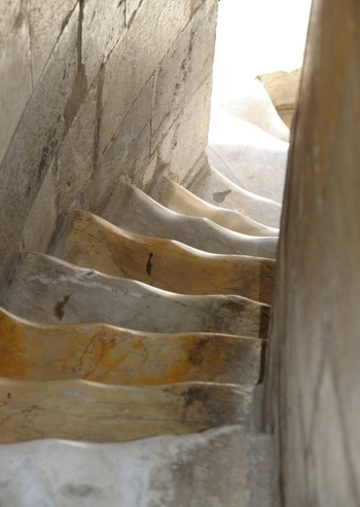.jpg)
(Click here to go back to Home Page)
The
Port of Livorno is about 15 miles from
Pisa and 55 miles to Florence.
As much as we would have liked to visit Florence, we could not do so if I wanted
to climb the Leaning Tower of Pisa (approximately
300 spiraling steps).
The
Leaning Tower of Pisa is a bell tower in the
city's Piazza del Duomo. The Piazza del Duomo also
houses the Duomo (the Cathedral), the Baptistry and the
Campo Santo (the monumental cemetery). The area is framed by medieval
walls kept by municipality administration.
The tower is situated behind the Cathedral and is the third oldest structure in
Pisa's Cathedral Square after the Cathedral and the Baptistry. The tower's tilt
began during construction, caused by an inadequate foundation on ground too soft
on one side to properly support the structure's weight. The tilt increased in
the decades before the structure was completed, and gradually increased until
the structure was stabilized (and the tilt partially corrected) by efforts in
the late 20th and early 21st centuries.
The height of the tower is 183.27 feet from the ground on the low side and
185.93 feet on the high side. The width of the walls at the base is 2.44 m (8 ft
0.06 in). Its weight is estimated at 14,500 metric tons. The tower has 296 or
294 steps; the seventh floor has two fewer steps on the north-facing staircase.
Prior to restoration work performed between 1990 and 2001, the tower leaned at
an angle of 5.5 degrees, but the tower now leans at about 3.99 degrees. This
means that the top of the tower is displaced horizontally 12 ft 10 in) from
where it would be if the structure were perfectly vertical.
_________________________________________
Entering Pisa
.jpg)
_________________________________________
That is me in the red shirt on top
.jpg)
.jpg)
Leaning Tower of Pisa steps - How many millions of people...some famous...some infamous...have climbed these worn steps?


.jpg)
.jpg)
_________________________________________
This picture shows a better view of the lean. Prior to restoration work performed between 1990 and 2001,
the tower leaned at an angle of 5.5 degrees. The tower now leans at about 3.99 degrees.
.jpg)
.jpg)
.jpg)
.jpg)
.jpg)
_______________________________________
A view from the top of the Tower of Pisa.
.jpg)
.jpg)
.jpg)
.jpg)
.jpg)
.jpg)
.jpg)
.jpg)
.jpg)
_______________________________________________
The Piazza del Duomo houses the Baptistry (far left), the Campo Santo (the monumental cemetery, the building
to the right of the Baptistry and behind the Cathedral), the Duomo (the Cathedral), and the Tower of Pisa.
.jpg)
_______________________________________________
The Baptistry on the left and the Campo Santo on the right.
.jpg)
_______________________________________________
The Campo Santo (the monumental cemetery)
The building was the fourth and last one to be raised in the Cathedral Square. It dates from a century after the bringing of the soil from Golgotha, and was erected over the earlier burial ground.
The construction of this huge, oblong Gothic cloister was begun in 1278 by the architect Giovanni di Simone. He died in 1284 when Pisa suffered a defeat in the naval battle of Meloria against the Genoans. The cemetery was only completed in 1464.
The Campo Santo contained a huge collection of Roman sarcophagi, but there are only 84 left together with a collection of Roman and Etruscan sculptures and urns, now in the Museum of the vestry board.
The sarcophagi were initially all around the cathedral, often attached to the building itself. That until the cemetery was built, then they were collected in the middle all over the meadow. Carlo Lasinio, in the years he was the curator of the Campo Santo, collected many other ancient relics that were spread in Pisa to make a sort of archeological museum inside the cemetery. Nowadays the sarcophagi are inside the galleries, near the walls.
.jpg)
.jpg)
_______________________________________________
The Baptistry
The Pisa Baptistry of St. John is a Roman Catholic ecclesiastical building in Pisa, Italy. Construction started in 1152 to replace an older baptistry, and when it was completed in 1363, it became the second building in the Piazza dei Miracoli.
The baptistry was designed by Diotisalvi, whose signature can be read on two pillars inside the building, with the date 1153.
.jpg)
_______________________________________________
Duomo (Pisa Cathedral)
The first stone of Pisa Cathedral was laid in 1093, initiating what would become the distinctive Pisan Romanesque style. The main architect was Buscheto, who is buried in the last blind arch on the left side of the facade. The facade itself was built by Buscheto's successor, Rainaldo.
A disastrous fire in 1595 destroyed most of the cathedral's medieval art, but some of the best Renaissance artists were hired for the redecoration work.
.jpg)
.jpg)
.jpg)
.jpg)
.jpg)
.jpg)
.jpg)
.jpg)
.jpg)
.jpg)
________________________________
The resting place of Saint Rainerius
(1117–1160). Rainerius is the
patron saint of
Pisa and of travellers.
.jpg)
.jpg)
.jpg)
.jpg)
.jpg)
.jpg)
.jpg)
.jpg)
.jpg)
.jpg)
.jpg)
.jpg)
.jpg)
.jpg)
.jpg)
.jpg)
.jpg)
.jpg)
.jpg)
.jpg)